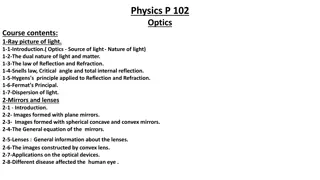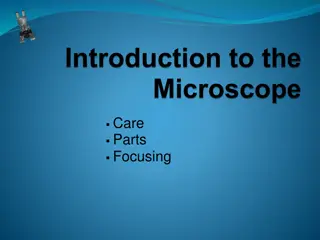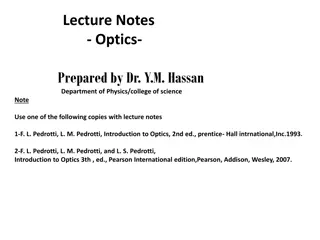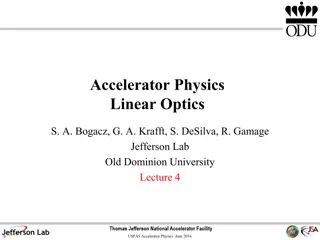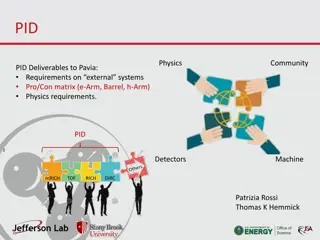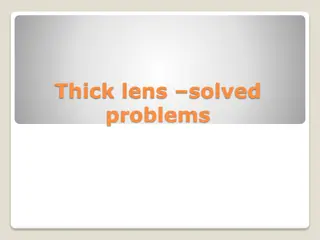Understanding Optics and Magnification in Physics
Today's lecture covers a brief review of optical instruments, Huygens principle, refraction phenomena, and Young's double slit experiment. The session delves into magnifying glasses, magnification power definition, astronomical telescopes, and simple and compound microscopes. Key concepts include the calculation of magnification power, angular magnification in telescopes, and the optics behind compound microscopes for scientific observation.
Download Presentation

Please find below an Image/Link to download the presentation.
The content on the website is provided AS IS for your information and personal use only. It may not be sold, licensed, or shared on other websites without obtaining consent from the author. Download presentation by click this link. If you encounter any issues during the download, it is possible that the publisher has removed the file from their server.
E N D
Presentation Transcript
Interference I: Double Slit Physics 2415 Lecture 35 Michael Fowler, UVa
Todays Topics First: brief review of optical instruments Huygens principle and refraction Refraction in fiber optics and mirages Young s double slit experiment
Convex Lens as Magnifying Glass The object is closer to the lens than the focal point F. To find the virtual image, we take one ray through the center (giving ) and one through the focus near the object ( ), again but now the (virtual) image distance is taken negative. = / / h h d d f i o i o 1 d 1 d 1 f ( ) = + = / / h h f d i o o o i hi hi ho F do f - do f di
Definition of Magnifying Power Mis defined as the ratio of the angular size of the image to the angular size of the object observed with the naked eye at the eye s near point N, which is ho/N. If the image is at infinity ( relaxed eye ) the object is at f, the magnification is (ho/f )/(ho/N) =N/f. (N = 25cm.) Maximum M is for image at N, then M = (N/f ) + 1. hi hi ho F do f - do f di
Astronomical Telescope: Angular Magnification An eyepiece lens of shorter focal length is added, with the image from lens A in the focal plane of lens B as well, so viewing through B gives an image at infinity. Tracking the special ray that is parallel to the axis between the lenses (shown in white) the ratio of the angular size image/object, the magnification, is just the ratio of the focal lengths fA/fB. A B fA fA fB fB
Simple and Compound Microscopes The simple microscope is a single convex lens, of very short focal length. The optics are just those of the magnifying glass discussed above. The simplest compound microscope has two convex lenses: the first (objective) forms a real (inverted) image, the second (eyepiece) acts as a magnifying glass to examine that image. The total magnification is a product of the two: the eyepiece is N/fe, N = 25 cm (relaxed eye) the objective magnification depends on the distance between the two lenses, since the image it forms is in the focal plane of the eyepiece.
Compound Microscope Total magnification M = Memo. Me = N/fe Objective magnification: f = e m o d f o o do fe fe fo fo objective eyepiece This is the real image from the first lens Final virtual image at infinity
Huygens Principle Newton s contemporary Christian Huygens believed light to be a wave, and pictured its propagation as follows: at any instant, the wave front has reached a certain line or curve. From every point on this wave front, a circular wavelet goes out (we show one), the envelope of all these wavelets is the new wave front. . Huygens picture of circular propagation from a point source. Propagation of a plane wave front.
Huygens Principle and Refraction Assume a beam of light is traveling through air, and at some instant the wave front is at AB, the beam is entering the glass, corner A first. If the speed of light is c in air, v in the glass, by the time the wavelet centered at B has reached D, that centered at A has only reached C, the wave front has turned through an angle. . B 1 1 A Air 2 D Glass C 2 The wave front AB is perpendicular to the ray s incoming direction, CD to the outgoing hence angle equalities.
Snells Law . If the speed of light is c in air, v in the glass, by the time the wavelet centered at B has reached D, that centered at A has only reached C, so AC/v = BD/c. From triangle ABD, BD = ADsin 1. From triangle ACD, AC = ADsin 2. Hence 1 sin sin B 1 1 A Air 2 D Glass C 2 BD AC c v = = = n 2 The wave front AB is perpendicular to the ray s incoming direction, CD to the outgoing hence angle equalities.
Fiber Optic Refraction Many fiber optic cables have a refractive index that smoothly decreases with distance from the central line. This means, in terms of Huygens wave fronts, a wave veering to one side is automatically turned back because the part of the wavefront in the low refractive index region moves faster: The wave is curved back as it meets the thinner glass layer
Mirages Mirages are caused by light bending back when it encounters a decreasing refractive index: the hot air just above the desert floor (within a few inches) has a lower n then the colder air above it: This is called an inferior mirage: the hot air is beneath the cold air. There are also superior mirages in weather conditions where a layer of hot air is above cold air this generated images above the horizon. (These may explain some UFO sightings.) The wave is curved back by the thinner air layer
Youngs Double Slit Experiment We ve seen how Huygens explained propagation of a plane wave front, wavelets coming from each point of the wave front to construct the next wavefront: Suppose now this plane wave comes to a screen with two slits: Further propagation upwards comes only from the wavelets coming out of the two slits
Youngs Own Diagram: This 1803 diagram should look familiar to you! It s the same wave pattern as that for sound from two speakers having the identical steady harmonic sound. BUT: the wavelengths are very different. The slits are at A, B. Points C, D, E, F are antinodes. Applet
Interference of Two Speakers Take two speakers producing in-phase harmonic sound. There will be constructive interference at any point where the difference in distance from the two speakers is a whole number of wavelengths n , destructive interference if it s an odd number of half wavelengths (n + ) . . Constructive: crests add together Destructive: crest meets trough, they annihilate
Interference of Light from Two Slits The pattern is identical to the sound waves from two speakers. However, the wavelength of light is much shorter than the distance between slits, so there are many dark and bright fringes within very small angles from the center, so it s bright where Waves from slits add constructively at central spot . Applet! First dark place from center: first-order minimum d = = sin d d n Path length difference is half a wave length n is called the order of the (bright) fringe
Interference of Light from Two Slits Typical slit separations are less than 1 mm, the screen is meters away, so the light going to a particular place on the screen emerges from the slits as two essentially parallel rays. For wavelength , the phase difference . d Path length difference is dsin sin d = 2
Measuring the Wavelength of Light For wavelength , the phase difference 2 = . sin d d and is very small in practice, so the first-order bright band away from the center is at an angle = /d. If the screen is at distance from the slits, and the first bright band is x from the center, = x/ , so = d = xd/ Path length difference is dsin = d = for 1st bright band from center. First bright band from center x
Light Intensity Pattern from Two Slits We have two equal-strength rays, phase shifted by . sin d = 2 d so the total electric field is sin E E = = Path length difference is dsin ( cos E ) + + sin t E + t tot 0 E 0 ( ) ( ) 2 sin t 1 2 1 2 We use the standard trig formula: + = 0 A B + A B 2 tot and the intensity is: sin sin 2sin cos A B 2 2 sin d ( ) ( ) 0 cos ( ) 0 cos = = 2 2 I I I Applet! 2
Actual Intensity Pattern from Two Slits Even from a single slit, the waves spread out, as we ll discuss later the two-slit bands are modulated by the single slit intensity in an actual two-slit experiment.


